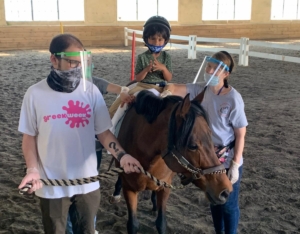Hippotherapy, as defined by the American Hippotherapy Association, refers to how occupational therapy, physical therapy, and speech-language pathology professionals use evidence-based practice and clinical reasoning in the purposeful manipulation of equine movement to engage sensory, neuromotor, and cognitive systems to achieve functional outcomes. In conjunction with the affordances of the equine environment and other treatment strategies, hippotherapy is part of a patient’s integrated plan of care.
Research suggests that Hippotherapy has positive effects on a patient’s posture, muscle tone, and balance. The movement of the horse engages muscles used for walking, and encourages postural responses which can help to improve trunk control, core strength, motor planning, sensory processing, and respiratory function for speech production. RHR uses equine movement to help treat impairments such as abnormal muscle tone, apraxia, sensory processing disorders, gait abnormalities, and motor coordination disorders associated with medical conditions such as autism, cerebral palsy, sensory integration disorder, developmental delays, brain tumors, traumatic brain injuries, and neuromusculoskeletal disorders.


